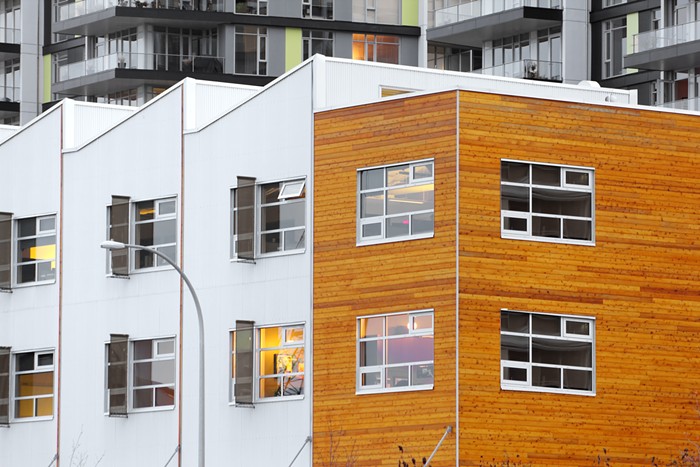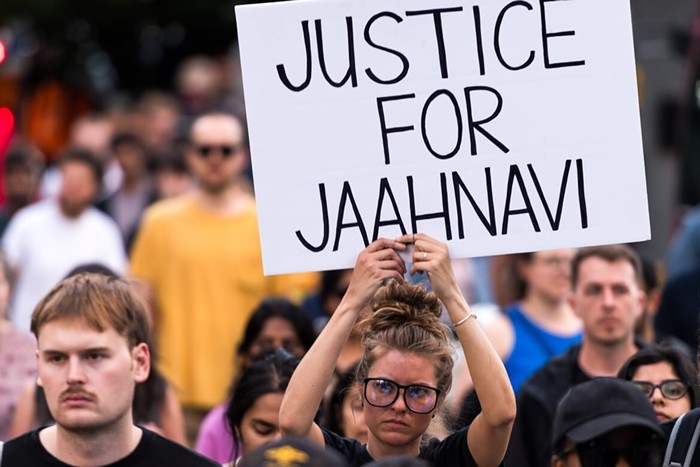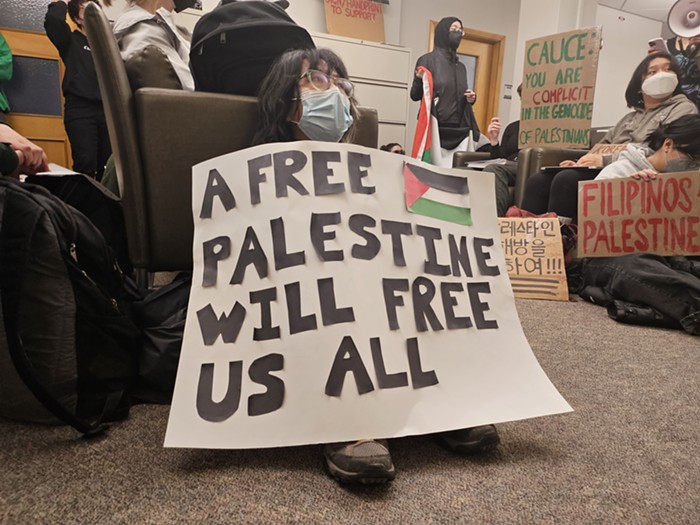Rainier Avenue in Rainier Beach is a depressed urban main line. Just up the street from the shopping center, at 9:30 last Wednesday night, cops handcuffed four black teens outside of a scruffy bar after somebody reported hearing gun shots. About a mile further south, shabby apartments beg for attention while rusted, stalled cars and other junk are piled up in yards. Neighbors think the answer to these problems is to fix up the center of the community, Beach Square.
Now, Safeway Inc., the nation's 40th most successful company and fourth largest grocery-store chain, has come to the rescue. The company wants to demolish its rotting Rainier Beach branch and other rundown businesses at Beach Square and replace them with a superstore--a mega grocery store with extras like a video shop and a bakery. Problem solved, right? No more drugs and prostitutes. Maybe. But Safeway's mall plans aren't exactly what the locals had in mind.
Residents want store entrances to meet the sidewalk, and they want to downplay the parking lot by putting it in the back and making the driveways less accessible. Safeway wants the building set back with a 300-stall parking lot in front of it. Neighbors want to build a nice-looking path along 52nd Avenue. Safeway wants to put a wall next to the neighbors' path. Residents want to retain small, independent local businesses. Safeway wants to displace about 80 percent of the businesses that are in Beach Square now.
"It's bad for me; I tried to build a business.... You cannot just move out after all the energy you put into the business," says Chai Ung, co-owner of Hunan Restaurant, a highly recommended sit-down Chinese food establishment that's currently burrowed in Safeway's bosom.
Poh Poh's Laundry has been at the center for 18 years, since owner Frank Viloria moved it from the University Village to be closer to his Rainier Beach home. "This is my livelihood," says Viloria. "I don't know if tomorrow the landlord will say, 'Get out.' I cannot hire a tough lawyer because I am only a laundry man."
Rainier Beach is a different world from refined Madison Park or apartment-dense Capitol Hill. It's Seattle's poorest neighborhood, and one of the most diverse. It encompasses a mix of residences and businesses--fast food restaurants, beauty shops, grocery stores, unpopular high schools. The neighborhood runs roughly from South Cloverdale Street on the north to South Fletcher Street on the south, and from Martin Luther King Jr. Way South on the west to Lake Washington on the east. Only about 3,000 people live there, according to the most recent data, 32.6 percent of whom live below poverty level. That poverty rate is twice as high as the rate in the rest of southeast Seattle, and more than double the poverty rate in the city as a whole. More than 60 languages are spoken in Rainier Beach.
Obviously, this neighborhood is a target for wealthy investors like Safeway, who can afford to slap down $2.8 million on a mall. Last year, Safeway's earnings were $7.3 billion off revenues of $30 billion. And the company is growing--its stocks have consistently risen this year, from $35 to $55--and it recently paid $1.7 billion to buy two giant companies (Randall's Food Markets Inc. and Carr-Gottstein Foods Co.).
The combination of Safeway's wealth and Rainier Beach's vulnerability is a recipe for gentrification. Despite disappointment with the specifics of Safeway's plans, neighbors are desperate for a change, and afraid of scaring off this willing corporate investor.
"That's what we want to see--something that's bright," says Brian Fairchild, who works at Windermere Real Estate in Rainier Valley. Fairchild is chair of the neighborhood chamber of commerce's Community Affairs Committee, and supports Safeway's plans. He calls the current shopping center "old and tired."
That kind of sentiment gives Safeway its cue. Rick Utt, of Cornerstone Architectural Group, presented the preliminary mall redesign to Rainier Beach community members at a meeting two weeks ago. At the meeting, the 25 residents and merchants who showed up learned for the first time that Safeway plans to knock down all but two businesses on the property (a restaurant with a bar, and an animal clinic). That would allow the old 22,000-square-foot Safeway to become a new 52,000-square-foot "super" Safeway with 300 parking spots leading up to the sidewalk and leeway to build on another 10,000 square feet in the future, according to the application the grocery chain filed with the city's Department of Design, Construction, and Land Use (DCLU) on October 2.
"The whole shopping center is a playground for people selling drugs and prostitutes. It's dark and scary," says Dawn Blanch, who was a co-chair of the neighborhood's planning committee. "But for us to create a suburban Safeway, where a large percent of the residents ride the bus and don't have a car, it's really inhospitable. Our neighborhood plan addressed all that stuff."
She's right. The plan recommends encouraging "pedestrian uses," "streetscape proposals to slow speeds through...Rainier Avenue," and emphasizes "business retention."
The Department of Neighborhoods representative for Rainier Beach, Sally Clark, has heard the complaints about Safeway and says the company could do better. "Redevelopment for redevelopment's sake doesn't do the neighborhood any good," says Clark. "Instead of tearing down those retail businesses, why not rehab them?" Clark says she's pushing other city officials, including the mayor's staff, to implore Safeway to talk their proposal over with the neighboring businesses.
The DCLU will give Safeway advice on the project in the next few weeks, which could incorporate feedback from the community. Then Safeway will submit its permit application.
Neighbors have little power to affect that application. The neighborhood plan is "a policy, not a code," according to DCLU planner Michael Jenkins, and Safeway doesn't have to follow it. Neighbors can appeal the DCLU's decision to okay a development, but the DCLU has no real power to turn down a developer who's complying with the zoning laws and city guidelines. Look what happened when Capitol Hill residents battled with Safeway over a redevelopment at 15th and John a few years ago. Residents wanted a front entrance, three more feet between the store and the sidewalk, and big trees. They didn't get any of it.
Architect Rick Utt was the only Safeway representative who met with Rainier Beach community members. Safeway did not return The Stranger's calls.


















